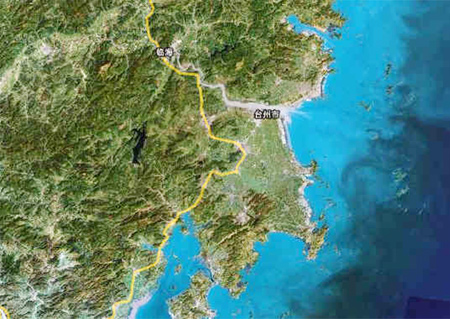About Taizhou

- Geography
-
Taizhou is situated in the middle of Zhejiang . With a land area of 9,411 sq. km. and shallow sea area of 80,000 sq. km., it has a population of 5.5592 million, of which 1.4737 million are in the urban area. The jurisdiction of Taizhou City encompasses three urban districts (Jiaojiang, Huangyan and Luqiao), two county-level cities (Linhai and Wenling) and four counties (Yuhuan, Tiantai, Xianjv and Sanmen). With a coastline of 745 km., it accounts for 28% of that of Zhejiang.
Taizhou belongs to the subtropical monsoon climate zone. Summer there is quite hot especially in July when the average temperature can be as high as 34C (93F). Winter is long but not too cold. The average temperature is about 4C (39F) to 8C (46F). Early May, late June and early September are rainy seasons.
- History
-
Taizhou has a long and rich history. 5,000 years ago, the ancestors began to settle in the area. It was called Huipu Town during the reign of Qin Dynasty (221-207 B.C.) and Huipu County since 85 B.C. in the Western Han Dynasty. In 257 A.D., Wu Kingdom of the Three Kingdoms Period set up Linhai Shire. In 621 A.D. during the Tang Dynasty it was named as Haizhou, and renamed Taizhou after the Mt. Tiantai within the boundaries of this city in the following year. After the founding of P.R.C., Taizhou had been a prefecture in the administrative division. With its administrative organ in Jiaojiang, Taizhou is a combined coastal city. On August 22, 1994, Taizhou Municipality was set up in place of Taizhou Prefecture and approved by the State Council. In 1999, Taizhou was approved by the State Council to be a leading city in Zhejiang's urbanization structure and the center of sub zone of the first-class economy. Approved by the National Development and Reform Commission, Taizhou formally became one of the 16 cities of Yangtze River Delta area on Aug.15, 2003.
- Culture Heritage
-
Taizhou enjoys a rich social culture and prosperous economy which can be traced all the way back to the Eastern Jin Dynasty, about 1600 years ago. In the Tang Dynasty, Zheng Qian, a famous scholastic official, devoted his life to the development of local education and culture. During the Southern Song Dynasty, Taizhou became a cultural and educational center. Taizhou boasts a large number of talented historical figures such as Dai Fugu and Qi Zhaonan to name just a few. 22 Taizhou-born persons have successively become academicians of Chinese Academy of Sciences (CAS) and Chinese Academy of Sciences (CAE).
"Siku Quanshu" is the complete library of the Body of Literature up to the Qing Dynasty. In this library are collected 141 books written by 107 Taizhou scholars. One book, Cuzhi Scripture, is the first entomological book of the world written by Jia Sidao of the Song Dynasty. Wuyue Youcao is the first book on economics written by Wang Shixing of the Ming Dynasty, and we have the Folk Veterinary Herbs, which was used for veterinary care of animals and filled the lack of an established veterinary science over the centuries.
Local traditional folk arts and crafts are well developed in Taizhou. Started in the Tang Dynasty and bloomed in the Qing Dynasty, "Needle-pierced boneless lantern", made in Xianju County, the land of China abounding in traditional Chinese folk arts and crafts, is known as the "First-grade Lantern of China". Arts and crafts made in Taizhou are world renowned, such as Taizhou Grass Carving, Wenling Stone Carving, Tiantai Woodcarving Figures of Buddha, Xianju Color Stone Mosaic and many, many more. Taizhou is the birthplace of southern China operas. "Taizhou Luantan", is one of 318 local operas in China, and took shape during the Qing Dynasty. Taizhou also produces colorful folk arts, such as Storytelling, Rylics to Dagu, Daoqing (chanting folk tales to the accompaniment of simple percussion instruments), Lion Dance, Boat Racing, Stilt-walking, Dragon Lantern Dance and many more forms of traditional Chinese heritage.
- Special Local Products
-
Handicrafts: glass sculpture, bamboo sculpture, stone sculpture, tree root carving, shell carving, waxwork, paper lantern, pearl.
Foods: Satsuma, waxberry, loquat, orange, shaddock, chestnut, long persimmon, sugarcane.

 Inquiry Basket (
Inquiry Basket (

